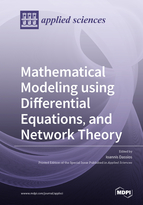Mathematical Modeling using Differential Equations, and Network Theory
A special issue of Applied Sciences (ISSN 2076-3417).
Deadline for manuscript submissions: closed (31 December 2019) | Viewed by 27916
Special Issue Editor
Interests: differential/difference equations; dynamical systems; modeling and stability analysis of electric power systems; mathematics of networks; fractional calculus; mathematical modeling (power systems, materials science, energy, macroeconomics, social media, etc.); optimization for the analysis of large-scale data sets; fluid mechanics; discrete calculus; Bayes control; e-learning
Special Issues, Collections and Topics in MDPI journals
Special Issue Information
Dear Colleagues,
This special issue aims at collecting latest results on Differential/Difference Equations, Mathematics of Networks, and their applications into Electrical Power Systems, Materials, Energy, Macroeconomics, etc.
This Special Issue will accept high-quality papers having original research results, and its purpose is to bring together Mathematicians with Physicists, Engineers, as well as other scientists.
Topics covered but not limited to:
- Differential/Difference equations
- Dynamical systems
- Mathematics of Networks
- Fractional calculus
- Modelling and Stability Analysis of Power Systems
- Discrete calculus
- Circuits Theory
- Signal Processing
- Materials Science
- Energy Systems
- Macroeconomics
Dr. Ioannis Dassios
Guest Editor
Manuscript Submission Information
Manuscripts should be submitted online at www.mdpi.com by registering and logging in to this website. Once you are registered, click here to go to the submission form. Manuscripts can be submitted until the deadline. All submissions that pass pre-check are peer-reviewed. Accepted papers will be published continuously in the journal (as soon as accepted) and will be listed together on the special issue website. Research articles, review articles as well as short communications are invited. For planned papers, a title and short abstract (about 100 words) can be sent to the Editorial Office for announcement on this website.
Submitted manuscripts should not have been published previously, nor be under consideration for publication elsewhere (except conference proceedings papers). All manuscripts are thoroughly refereed through a single-blind peer-review process. A guide for authors and other relevant information for submission of manuscripts is available on the Instructions for Authors page. Applied Sciences is an international peer-reviewed open access semimonthly journal published by MDPI.
Please visit the Instructions for Authors page before submitting a manuscript. The Article Processing Charge (APC) for publication in this open access journal is 2400 CHF (Swiss Francs). Submitted papers should be well formatted and use good English. Authors may use MDPI's English editing service prior to publication or during author revisions.






